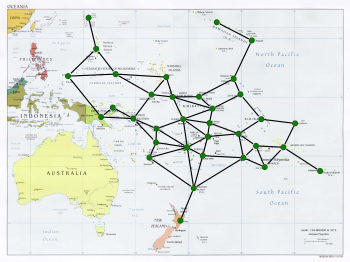Notes:
– Map rather similar to Clippers’ map (prob minus double routes and keeping directionality in a few areas). Possibly more islands and more linkages.
– Resources come in 5 or 6 colours and occur in two types (which we’ll call big and small). There are far fweer big than small. Big are demands, small are products. There are thrice as many small than big in each colour.
– One random big is placed on each larger island along with one small. Two more smalls are placed beside the island in an ordered sequence. Ensure that smalls are not placed on islands with bigs of the same colour.
– Game starts with players in a random order.
– Each player in turn nominates a linkage by placing their player marker on it (each player has only one of these)
– In rotation in player order players may bid on nominated routes by placing money beside a player’s marker and placing an ownership token atop the money. Players may only bid if their bid exceeds or equals any other individual bid on that route. Players may pass.
– Once all players have passed the player whose nominated route garnered the highest bid goes first. They may either take (their choice) of the higest bid, thus allowing that player to build/claim that route, or they may build/claim the route themselves. Repeat for other players, tie breaker for ordering is passing order. (Nash equilibria problem here)
– Possibly limit nominations to those connected to starting locations or to prior built routes.
– Cost of routes? Preset?
– When a route is built connecting two islands, the top small on each end (if any) is produced onto the island. If there are none left, or the island is too small to have any, none are produced.
– Possibly re-order players to match build order.
– Once all players have had the option to build/claim, each player may perform two deliveries (AoS-style). Smalls may be delivered to bigs and bigs may be delivered to small. Smalls may not be delivered away from an island containing one or more bigs of the same colour, and likewise for bigs. (ie this is a sorting game)
– When delivering over a route the owning player receives one income on the income track.
– The delivering user is paid in income equal to the number of smalls of a matching colour there are on the target island.
– Three smalls of colour matching a big are removed from the island and the big given to the delivering player. (Figure out a reason later)
– Players may pass on a delivery to increase their AoS-style? Links.
– Nice to blend in something like a Business Development action to seed more bigs and smalls on islands. Not sure how to add SP&R.
– A delivery through an empty major island (can or has contained bigs or smalls) costs an income.
Repeat until No deliveries are possible and N or less bigs are left on board.
– Scoring looks like bigs are worth a lot of points with money being a minor source (possibly requiring an action to trade in).
– Income might be traded for VPs at the time of generation, 2:1 (figure out what to do with rounding?). Ditto later in the other direction. Players should start with ~10 VPs? Better ratios? 3:1 and 2:3? Asymmetry?
